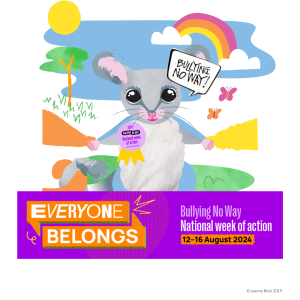Myth: There’s no such thing as bullying in the early years!
Fact: Even children as young as 3* can participate in bullying behaviour. As we raise awareness around the Bullying No Way week of action, it’s important to distinguish the difference between bullying and other social interactions that are common in the early years. Children have the right to choose who they do and don’t engage with, they are still learning about the feelings of others and discovering their sympathy and empathy towards others when it comes to things like sharing, refusals and bouts of unregulated frustration – but! Bullying is different, and the key difference that the behaviour becomes:
As we raise awareness around the Bullying No Way week of action, it’s important to distinguish the difference between bullying and other social interactions that are common in the early years. Children have the right to choose who they do and don’t engage with, they are still learning about the feelings of others and discovering their sympathy and empathy towards others when it comes to things like sharing, refusals and bouts of unregulated frustration – but! Bullying is different, and the key difference that the behaviour becomes:
- Targeted
- Repetitive
- Intentionally hurtful
- and it involves an imbalance of power.
I wonder if you can guess, based on the above, which scenario depicts bullying behaviours:
“Percy asks Bennet the Wallaby if he can play with her and the rest of his pals. Bennet says, “No, go away.” which hurts Percy’s feelings. Percy tries again later and eventually finds a way to enter the game. Bennet isn’t actively encouraging Percy to play but she’s also no telling him to leave the game. Percy and Bennet have the same interaction again the next day, but this time Bennet sees Percy become upset and changes her mind, “Ok ok …” she huffs and Percy joins in.”
-Or-
“Percy asks Bennet the Wallaby if he can play with her and the rest of his pals. Bennet says, “No, go away.” which hurts Percy’s feelings. Bennet laughs at this and calls Percy a big baby. The next day Bennet sees Percy in the sandpit and asks him, “are you going to cry again, big baby?” this hurts Percy’s feelings again, he’s also left feeling very confused, “Did I do something wrong?” For the rest of the week, every time Bennet sees Percy at Bush Creche, she calls him a baby and laughs. Now every time Percy sees her, he becomes anxious and hides instead of playing. Poor Percy.
This second scenario depicts bullying in the playground, the first (though not ideal) is fairly typical behaviour that is both age and developmentally appropriate for a 3-5 year old. Both scenarios are excellent opportunities for supporting the emotional development, resilience and sense of self in the children at this ‘care setting’. raisingchildren.net.au has some amazing tips, resources and guides on their website for parents, educators, teachers and children. You can find them here: https://raisingchildren.net.au/…/preschool-bullying…
*[Source of evidence for bullying behaviour shown in children as young as 3 years old: Vlachou, M., Andreou, E., Botsoglou, K., & Didakalou, E., (2011). Bully/victim problems among preschool children: a review of current research evidence Educational Psychology Review. 23(3). 329.]


